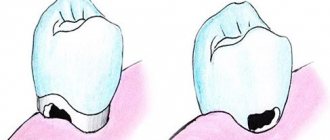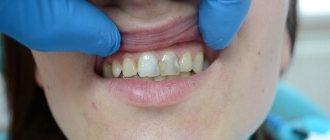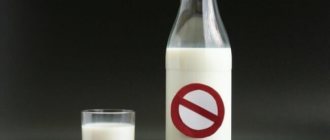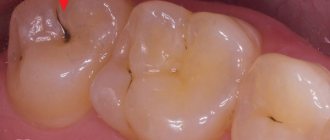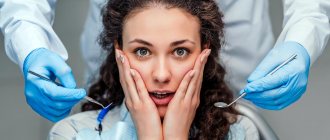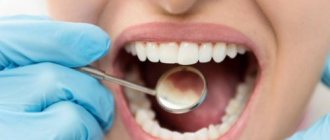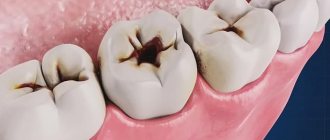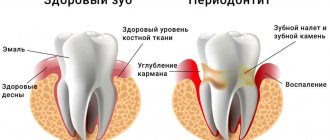Features of superficial caries
Among the main distinctive features of superficial carious damage to teeth in children in comparison with other forms of pathologies, the following should be noted:
- only the enamel layer is affected by pathogenic formations. The dentin remains intact. With timely treatment, the risks of complications are minimal;
- the occurrence of an acute reaction to external stimuli, for example, sour and sweet foods, low and high temperatures;
- if superficial caries is diagnosed in children, treatment can be carried out without tissue preparation;
- Most often, the superficial form occurs in children aged 3-4 years and in adolescents.
Note! Initial caries and superficial caries are two completely different forms. The first appears as a small spot, the second occurs in the absence of treatment. It can be recognized by the presence of small-sized carious cavities.
Diagnostics
Multiple caries is diagnosed by a dentist when:
- interviewing and collecting patient complaints;
- visual examination of the oral cavity and instrumental examination of teeth;
- determining the KPU index (the number of filled and extracted teeth in the patient’s oral cavity).
Among the additional research methods, experts conduct the following.
- Vital coloring method.
Maximum informative at the stage of initial caries. It is based on the ability of the dye to penetrate into porous (destroyed) layers of enamel that are not visually visible.
- Transillumination.
It is based on the ability of a carious cavity to form a shadow when the crown is illuminated by a stream of bright light from the opposite side. To carry out transillumination, dentists use light from the blue spectrum of conventional photopolymerization lamps. The method helps to detect hidden cavities.
- UV-scopy.
A method that allows the use of ultraviolet irradiation to diagnose initial forms of caries, as well as determine secondary caries in previously filled teeth. Based on the ability of healthy enamel to glow under the influence of blue light. With blooming caries, luminescence is extinguished. It is carried out to determine the activity of the carious process and its prevalence.
- Calorimetric test.
Helps determine the high activity of multiple caries, thanks to the study of the pH value of saliva.
- Test to determine the viscous properties of saliva.
And a method for assessing the rate of salivation, which is carried out after a chewing test with paraffin. It is based on a significant decrease in the rate of salivation during illness (normally 1 ml/min).
Differential diagnosis
When making a diagnosis, multiple caries is differentiated from:
- wedge-shaped defect;
- enamel hypoplasia;
- fluorosis.
With a wedge-shaped defect in the cervical region of the frontal surfaces, lesion areas of a regular, characteristic wedge-shaped shape are determined, directed towards the pulp, with a shiny, smooth surface.
Enamel hypoplasia manifests itself in childhood, is usually asymptomatic and is accompanied by the appearance of chalky spots with a shiny surface and clear edges on permanent or baby teeth. The lesion is characterized by symmetry. With multiple caries, pathological foci are located asymmetrically, have a matte surface and unclear boundaries.
Fluorosis is characterized by endemicity - groups of people living in areas where there is a high fluoride content in the water are affected. With fluorosis, spots with a shiny surface appear on the teeth, symmetry is not typical for them, and permanent teeth are affected. Lesions in fluorosis and enamel hypoplasia are not stained, while carious cavities are stained with dyes.
Symptoms of the disease
Symptoms of superficial foci of caries are manifested by the following signs:
- visible defect. On the surface of the tooth there is a small cavity with uneven edges. The color of the formation is dark, the bottom is slightly rough;
- pain syndrome. When exposed to cold, hot, sweet and sour foods or drinks, sharp short-term pain occurs;
- hyperesthesia. When inhaling cold air, while brushing your teeth, increased sensitivity occurs.
These are the main symptoms and in each individual case they can manifest themselves differently.
Factors influencing the development of superficial caries in children
The fundamental factors that result in superficial caries in children are:
- eating foods that contain large amounts of carbohydrates;
- non-compliance with hygiene rules: insufficient brushing of teeth, ignoring periodic rinsing with special means, etc.;
- drinking water with a deficiency of fluoride in its composition;
- deficiency of vitamins and mineral elements;
- severe systemic diseases;
- hormonal imbalance;
- ignoring professional hygiene, the need for which arises every 5-6 months.
Any of these factors or several at once are the primary causes of tooth enamel destruction.
Principles of treatment of superficial caries
When superficial caries is detected in children, treatment should be aimed not only at eliminating formations on the tooth enamel, but also at preventing the re-development of the pathology. To prevent complications, comprehensive and immediate therapy is necessary.
When talking about treatment, it should be understood that it is just beginning in the dentist’s office, and it will also need to be continued at home using special means and traditional medicine recipes.
Features of treatment in the pediatric dentist's office
If baby teeth are damaged by caries, then it is quite possible to treat them conservatively without the use of drills, which almost every child is afraid of. Modern dentistry offers more gentle and comfortable methods:
- Children under 3 years of age undergo silvering or deep fluoridation of their teeth. If the enamel has already been damaged by caries, it is cleaned of plaque and treated with a laser. If necessary, cracks in the chewing and frontal teeth are sealed;
- at the age of 3 to 5 years, ozone therapy can be performed to eliminate the first stage of superficial caries, and in case of major complications, treatment is carried out using the method of depophoresis. Its essence lies in the introduction directly into the root canals of a special composition with calcium and copper;
- Children from 5 to 9 years old undergo filling. Glass ionopolymers or colored compomers are used for fillings;
- Children aged 9 to 12 years already have molars and adult technologies can be used to treat them with minimal trauma. But in most cases, therapy of chewing teeth is carried out by sealing fissures.
When superficial caries in children requires complex dental procedures, local anesthesia is mandatory before such procedures are performed. If removal is necessary, such an intervention can be performed under intravenous anesthesia.
Treatment at home
Along with professional treatment of caries by a pediatric dentist, proper oral care at home will also be required to obtain an effective result. For this purpose, special rinsing compositions and toothpastes with anti-caries effects are used.
For children under 4 years of age, dental and oral care products should not contain fluoride. The therapeutic effect is provided by antibacterial active components and calcium ions.
Children over 4 years old are allowed hygiene products containing fluoride, only the concentration of the element must be minimal.
LACALUT kids, PresiDENT Baby, SILPA Putzi, Splat junior are considered good toothpastes for children. You need to brush your teeth with them twice every day. Among the rinses, Drakosha for children, Active Kids, and LACALUT Teens have proven themselves well. When treating caries with such solutions, it is necessary to rinse your mouth after every meal and always before going to bed.
In addition to professional medications, you can also use remedies prepared according to alternative medicine recipes:
- An infusion of chamomile is perfect as a rinse. To do this, pour a glass of boiling water into 1 tbsp. l. dried flowers, leave and cool to room temperature;
- a weakly concentrated solution of sea salt has a positive effect on the condition of teeth. Dissolve 0.5 teaspoons of salt in a glass of water and use for rinsing.
Important! Rinse aids can only be used after the child reaches 1.5-2 years of age, when he can already rinse and spit out liquid on his own, rather than swallow it.
Treatment of multiple dental caries
First of all, treatment should be comprehensive, especially if caries is caused by general diseases. After all, if you do not eliminate the reason why your teeth are decaying, then the treatment will be in vain: the carious process will begin all over again. Experienced pediatric dentists in such cases refer the little patient to the appropriate specialists.
Modern dentistry is aimed at maximum preservation of teeth, and even milk teeth. After all, if you remove them ahead of time, problems with the eruption of the radical units may subsequently arise. In order to prevent the destruction of hard dental tissues, the specialist prescribes the following measures:
- at the chalk stain stage, dentin and enamel strengthening minerals (F, Ca) are used;
- at the middle stage, carious cavities are cleaned and closed with a filling;
- in case of deep damage, the tooth pulp is partially or completely removed, the canals are cleaned, filled with composite, and a filling is installed.
A small patient who has undergone treatment for multiple caries must then be observed by a doctor once every three months. If prevention requirements are not followed, the process may begin to develop again.
Possible complications
Some parents are in no hurry to visit a pediatric dentist because they consider it useless to treat baby teeth. This approach is explained by the fact that permanent ones will grow instead of them anyway.
Although the carious process itself does not transfer from baby teeth to permanent ones, untreated caries lesions have a detrimental effect on the condition of the latter. If you ignore superficial caries in children , complications may very soon manifest themselves:
- caries progresses rapidly in the absence of adequate therapy. This leads to the development of periodontitis and damage to the molar tooth germ. The inflammatory process significantly slows down the eruption of permanent teeth and complicates their growth;
- premature loss of baby teeth leads to the formation of malocclusion and disrupts the structure of the maxillofacial system;
- If at least one tooth is missing in the dentition, this complicates the process of chewing food. As a result, problems arise with the functioning of the digestive system.
Remember! Even the smallest stain can lead to complete tooth decay. There is no need to risk your child's health. It is much easier to visit the dentist and, if necessary, treat caries.
Is it necessary to treat childhood caries?
- Since baby teeth are a “temporary” phenomenon, adults believe that caries does not need to be treated. However, this is a myth. It is necessary to regularly, carefully and fully care for the child’s oral cavity;
- Destruction by caries can reach such depths that it can affect permanent units and destroy their enamel;
- When removing a baby tooth, you need to understand that the neighboring one quickly moves into its place, for this reason the permanent one erupts in the wrong place. It will have to be corrected with braces;
- There is a decrease in the immune system, which causes serious ENT diseases and allergic reactions;
- Toothache prevents a child from biting and chewing food normally, which can lead to digestive problems.
Treatment is necessary regardless of the patient's age.
